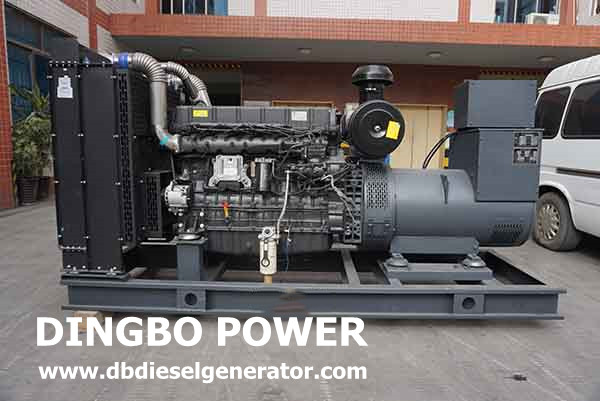The Methods for Removing Carbon Deposits from Shangchai Generator Set
by Dieselgenerator Tech ***Carbon deposit is a complex mixture formed by the incomplete combustion of diesel oil and engine oil infiltrated into the cylinder. The thermal conductivity of carbon deposit is poor, and a large amount of carbon deposits on the surface of the part will cause the part to overheat locally and reduce its rigidity and strength. In severe cases, serious accidents such as sintering of the injector coupler, valve ablation, piston ring jamming, and cylinder pulling may also occur. In addition, the large accumulation of carbon deposits pollute the lubrication system of Shangchai diesel generator sets, block oil passages and filters, and shorten the service life of the generator. Therefore, when the Shangchai diesel generator sets have too much carbon, they must be removed in time. Generator manufacturer-Dingbo Power introduce to you the methods for removal of carbon deposits.

1. Mechanical law
It uses wire brushes, scrapers, bamboo chips or emery cloth to remove carbon deposits. Special brushes and scrapers can be made according to the shape of the parts to be cleaned: For example, the carbon deposit around the nozzle hole of the injector can be cleaned with a thin copper wire brush; the carbon deposit in the pressure chamber can be inserted with a special through needle made of copper wire Use a cylindrical metal brush to remove carbon deposits on the valve guide and valve seat. The mechanical method for removing carbon deposits has low work efficiency and poor removal quality. Some parts are difficult to scrape clean, and many small scratches are left, which become the growth points of new carbon deposits and increase the roughness of the parts. Therefore, this method is generally not suitable for high-precision parts.
2. Spray nucleus method
It is a method of spraying crushed walnut, peach, and apricot peach husk particles onto the surface of parts by high-speed airflow to remove carbon deposits. This method is highly efficient and completely clean in removing carbon deposits, but requires special equipment to form high-speed airflow, and the cost is relatively high, so it is not suitable for widespread use.
3. Chemical law
It is a method of using a chemical solvent-decarburizing agent to soften the carbon deposits on the surface of the parts so that they lose their ability to bond with metals, and then remove the softened carbon deposits. This method has high efficiency and good effect in removing carbon deposits, and it is not easy to damage the surface of ring parts.
1) Decarburizing agent generally consists of 4 components: carbon deposition solvent, diluent, slow release agent and active agent. There are many types of decarburizing agents. According to the different materials of metal parts, they can be divided into steel decarburizing agents and aluminum decarburizing agents. The above decarburizing agents contain chemically corrosive components (such as caustic soda) for aluminum products. Therefore, it is only suitable for decarbonizing steel parts. When using inorganic decarburizing agent, heat the solution to 80-90°C, soak the parts in the solution for 2h, and take it out after the carbon deposits soften; then, use a brush to remove the softened carbon deposits, and then use the content of 0.1%- Clean with 0.3% potassium dichromate hot water; finally, wipe it dry with a soft cloth to avoid corrosion.
2) Organic decarburizing agent: a decarburizing solvent prepared from organic solvents, which has strong decarburization ability, has no corrosive effect on metals, and can be used at room temperature. It is mainly used for decarbonization of precision parts.
①Formulation 1: Hexyl acetate 4.5%, ethanol 22.0%, acetone 1.5%, benzene 40.8%, stone vinegar 1.2%, ammonia 30.0%. When formulating, just weigh it according to the above weight percentage and mix it evenly. When in use, soak the parts in the solvent for 23h; after taking it out, dip a brush in gasoline to remove the softened carbon deposits. This solvent is corrosive to copper, so it is not suitable for the decarbonization of copper parts, but it has no corrosive effect on steel and aluminum parts. This formula also has the effect of removing the old paint layer. Note: The working environment should have good ventilation conditions during use.
②Formulation 2: kerosene 22%, turpentine 12%, oleic acid 8%, ammonia 15%, phenol 35%, oleic acid 8%. The preparation method is to first mix kerosene, gasoline, and turpentine according to the (weight) ratio, then mix with phenol and oleic acid, add ammonia water, and keep stirring until it is orange-red transparent liquid. When in use, put the parts to be decarbonized in the solvent, soak for 23h, wait until the carbon deposits are softened, and then brush them off with gasoline. This formula does not apply to copper parts.
③Formulation 3: First-run diesel 40%, soft soap 20%, mixed powder 30%, triethanolamine 10%. When preparing, first heat the mixed powder to 80-90°C, add soft soap under constant stirring, add the first-run diesel oil when all of it is dissolved, and finally add the triethylamine. When in use, put the parts in a sealed container, heat to 80-90°C with steam, and soak for 2-3h. The formula has no corrosive effect on metals.
The above is the removal method for carbon deposits of Shangchai diesel generator set. Carbon deposits have a great impact on the performance of the generator. Therefore, during the repair process, you can choose the specific implementation method according to the formation position of the carbon deposits and your conditions. In order to effectively remove carbon deposits, special maintenance is needed for generators, Dingbo Power, as one of leading generator manufacturer, we has a team of professional technicians and experts on the debugging and maintenance, should there is any problem or you are interested in purchasing Shangchai Genset, please contact by dingbo@dieselgeneratortech.com
Sponsor Ads
Created on Feb 20th 2023 20:55. Viewed 140 times.



